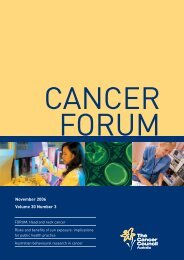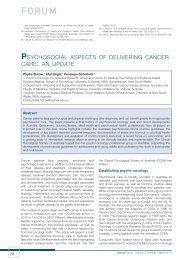Cancer Forum
Cancer Forum
Cancer Forum
- No tags were found...
You also want an ePaper? Increase the reach of your titles
YUMPU automatically turns print PDFs into web optimized ePapers that Google loves.
ookreviewsCANCER CHEMOPREVENTIONR Bergen (ed)Published by Kluwer Academic (2001)ISBN: 079237259X. 306 pages plus index.RRP: US$205.00This book, coming as it does in a series of oncologypublications, marks again the entry of cancer chemopreventioninto mainstream academic thinking in oncology. The National<strong>Cancer</strong> Institute’s definition of a comprehensive cancer centrepays equal credence to the pre-diagnostic management ofcancer as it does to the more conventional post-diagnosticphase. It is perhaps no surprise therefore that the editor andmany of the chapter authors come from the Robert H LurieComprehensive <strong>Cancer</strong> Center at Northwestern UniversitySchool of Medicine in Chicago. As Australia heads also to buildits cancer services to the US model, the book is a timely entryinto the field.The initial four chapters are about generic disciplines in thefield, covering agent identification and preclinical testing;intermediate biomarkers; tissue microdissection andprocessing; and basic pharmacokinetics and pharmacodynamicprinciples. The first of these chapters, by Jim Crowell at theNational <strong>Cancer</strong> Institute (NCI), is a striking account of thesystematic approach taken by the Division of <strong>Cancer</strong>Prevention in its Chemopreventive Agent DevelopmentResearch Group. First there is a careful scouring of theliterature and, quite admirably, medical folklore from culturesaround the world, for clues about agents whose scientific basismay be a lot more than folklore. This approach has the benefitof ready-made “post marketing” experience, as there may wellbe centuries of human exposure information, though not wellcomparedwith a placeb. So there develops an understandingof the mechanisms of action and pharmacodynamics of agentslike curcumin (from tuberose plants in India), polyphenols (fromgreen teas in the Far East) and others. Of course, the NCI alsosupports more traditional approaches to agents identifiedthrough observational epidemiology on humans. For example,after Professor Gabriel Kune’s groundbreaking observationabout the possible protective role of aspirin in the MelbourneColorectal <strong>Cancer</strong> Case-Control study in the early 1980s, thesingularly consistent reproduction of the 50% risk reductionfrom well over 50 case control and cohort studies world-widehas made aspirin an obvious target for the NCI’s attention. Thisis well-described in the chapter and, indeed, the role ofcyclooxygenase and its downstream (prostanoids) metabolicproducts in cancer promotion is a theme throughout the book– as well as possible non-cox inhibitor mechanism of action ofaspirin and the nonsteroidal anti-inflammatory drugs.The agency is also engaged in carrying ideas forward that mayemerge from “high tech” discoveries such as DNA microchiptechnology, or functional proteomics. The steps that follow areimpressively comprehensive, including mechanistic prescreeningthrough a variety of standard assays (eg signaltransduction modulation, including those targeting growthfactors, oncogenes and tumor suppressors; anti-hormones,anti-inflammatories, antimutagens, antioxidants, apoptosisand angiogenesis). In vitro efficacy models, in vivo short-termscreening using intermediate endpoints and animal modelefficacy testing are all described in the systematic process ofcandidate product development before clinical trials. Safetyand dosage information is collected in the later phases oftoxicology and pharmacology studies in an equally systematicfashion.135The intermediate biomarker chapter highlights the gapbetween the need for biomarkers to hasten the drugevaluation process in humans, and the difficulty in validatingsuch markers as truly surrogate for the cancer endpoint.Despite millions being spent in this area by the NCI, there islingering uncertainty with most markers about their validity.Molecular biological (LOH, mutations in oncogenes,methylation) and cell biological (proliferation apoptosis),growth, factor or receptor status consistency is comforting, butthe ultimate validation must come from years of prospectiveobservation to the cancer endpoint in question – in humans.Thus there are doubts about even historically the earliestputative intermediate endpoints described such as proliferation(titrated thymidine, PCNA, etc studies).Tissue microdissection and processing has truly been abreakthrough as the ability to isolate even single cells fromfrozen and paraffin-embedded sections has bolsteredsubstantially both the sensitivity and specificity of molecularbiological observations and enabled much more finely tuned,stage-specific information to emerge. This is well-described.To the pharmacologically-lay reader, the chapter on kineticsand dynamic principles points out the essential need for expertpharmacology to be engaged in the process of development ofpreventive agents. It is no surprise, therefore, that the bestcentres in chemoprevention in the USA have pharmacologyexpertise at their helm (eg Dave Alberts in Tucson).The balance of the book is organ-specific chapters onchemoprevention. These become repetitive to thecomprehensive reader, although necessarily may be so to caterfor organ specialists delving exclusively into their own niche.The repetitious themes do, to this reviewer, highlight thetremendous contribution made by investigators such asKnudson (two hit hypothesis) and Vogelstein (the Vogelgramof cumulative genetic events leading to cancer) to ourunderstanding of cancer. The variety of these latter events indifferent cancers appears sprinkled throughout the chaptertexts, without any attempt to draw them together as a “cancertheme”. Of course the state of knowledge is emerging,especially with respect to our understanding of thedownstream consequences of perturbations to theseoncogene and tumour suppressor phenomena, but the bookwould have contributed more with such an overview. It is clearthat knowledge is advancing much more rapidly in organsmore accessible to premalignant observation and diagnosis (egskin, bladder, colon, upper GI tract) as the molecular eventsthat characterise these early developments are pinned downmechanistically and statistically with the help of clinicalinvestigators. So too are clinical trials of the new agents, as themore advanced intermediate endpoints (actinic keratoses, earlytransitional cell carcinoma, adenomatous polyps, Barrettsdysplasia) can be effectively monitored. The understanding ofskin cancer proved particularly impressive to this nondermatologist.Throughout the organ-specific chapters, there was a surprisingconsistency of themes of cancer chemoprevention candidates.NSAIDs, including particularly the COXibs, isoflavones (fromthe epidemiological dietary literatureon vegetables), genistein(a soy derivative) difluoromethyl ornithine (from studies of therole of polyamines in cancer proliferation), oltipraz, n-acetylcysteine and retinol and its derivatives (over 4000!). Of thelatter, fenretinide received a promising brief (efficacy andsafety) from a number of chapter authors. In contrast, the late20th century fixation on antioxidants in pharmacological andsuprapharmacological doses provides an historical rendition of<strong>Cancer</strong> <strong>Forum</strong> ■ Volume 26 Number 2 ■ July 2002









